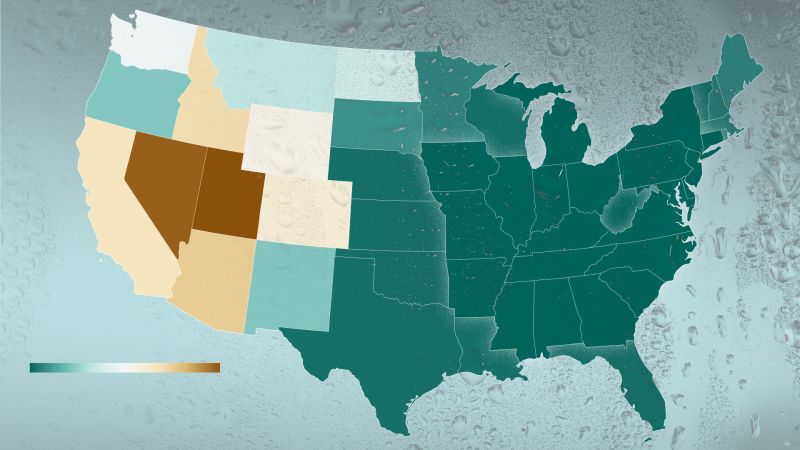Is It The Heat Or The Humidity? Decoding This Summer's Uncomfortable Weather

Welcome to your ultimate source for breaking news, trending updates, and in-depth stories from around the world. Whether it's politics, technology, entertainment, sports, or lifestyle, we bring you real-time updates that keep you informed and ahead of the curve.
Our team works tirelessly to ensure you never miss a moment. From the latest developments in global events to the most talked-about topics on social media, our news platform is designed to deliver accurate and timely information, all in one place.
Stay in the know and join thousands of readers who trust us for reliable, up-to-date content. Explore our expertly curated articles and dive deeper into the stories that matter to you. Visit Best Website now and be part of the conversation. Don't miss out on the headlines that shape our world!
Table of Contents
Is It the Heat or the Humidity? Decoding This Summer's Uncomfortable Weather
Summer's here, and for many, that means sweltering heat and oppressive humidity. But what's the real culprit behind that sticky, uncomfortable feeling? Is it the heat, the humidity, or a wicked combination of both? Let's dive into the science behind this summer's weather woes and learn how to better cope with the discomfort.
The Heat Index: More Than Just a Number
While the temperature on your thermometer might read 90°F (32°C), the actual feel of that temperature is often much higher, thanks to humidity. The heat index, also known as the apparent temperature, combines air temperature and relative humidity to calculate how hot it actually feels to the human body. This is crucial because high humidity hinders the body's natural cooling mechanism – sweating.
When the air is humid, it's already saturated with water vapor. This means your sweat evaporates much more slowly, reducing its effectiveness in cooling your skin. The result? You feel hotter and more uncomfortable than the thermometer suggests. You can find heat index charts online (like those provided by the National Weather Service) to get a better understanding of how the current conditions affect you.
Humidity: The Silent Discomfort
Humidity, simply put, is the amount of water vapor in the air. High humidity levels make the air feel heavy and sticky, hindering evaporation and making it harder for your body to regulate its temperature. This can lead to heat exhaustion and, in extreme cases, heat stroke. Understanding relative humidity – the percentage of water vapor present in the air compared to the maximum amount it can hold at a given temperature – is key to understanding the discomfort. 100% relative humidity means the air is completely saturated, leaving no room for sweat evaporation.
Heatstroke vs. Heat Exhaustion: Knowing the Difference
It's vital to differentiate between heat exhaustion and heatstroke. Heat exhaustion is characterized by symptoms like heavy sweating, weakness, dizziness, headache, and nausea. While serious, it's generally treatable with rest and rehydration. Heatstroke, however, is a life-threatening emergency. Symptoms include high body temperature (above 103°F or 39.4°C), confusion, seizures, and loss of consciousness. If you suspect heatstroke, call emergency services immediately.
Staying Safe in Hot and Humid Weather
Staying safe during periods of high heat and humidity requires proactive measures:
- Stay hydrated: Drink plenty of water throughout the day, even before you feel thirsty.
- Seek air conditioning: Spend time in air-conditioned spaces, especially during the hottest parts of the day.
- Wear light-colored, loose-fitting clothing: This allows for better air circulation and reduces heat absorption.
- Limit strenuous activity: Avoid intense physical activity during the hottest hours of the day.
- Check on vulnerable individuals: Elderly people, young children, and those with underlying health conditions are particularly susceptible to heat-related illnesses.
- Use sunscreen: Protect your skin from the sun's harmful UV rays.
- Monitor the heat index: Pay close attention to weather forecasts and heat index reports.
Understanding the weather is crucial for personal safety and well-being. By understanding the interplay between heat and humidity, you can take the necessary precautions to stay safe and comfortable throughout the summer. Remember, preparedness is key to beating the heat!

Thank you for visiting our website, your trusted source for the latest updates and in-depth coverage on Is It The Heat Or The Humidity? Decoding This Summer's Uncomfortable Weather. We're committed to keeping you informed with timely and accurate information to meet your curiosity and needs.
If you have any questions, suggestions, or feedback, we'd love to hear from you. Your insights are valuable to us and help us improve to serve you better. Feel free to reach out through our contact page.
Don't forget to bookmark our website and check back regularly for the latest headlines and trending topics. See you next time, and thank you for being part of our growing community!
Featured Posts
-
 Uk Car Industry Crisis Can It Survive
Aug 14, 2025
Uk Car Industry Crisis Can It Survive
Aug 14, 2025 -
 Emotional Farewell The Last Speech Of The Fallen Cdc Shooting Officer
Aug 14, 2025
Emotional Farewell The Last Speech Of The Fallen Cdc Shooting Officer
Aug 14, 2025 -
 Kike Hernandez Injury Update Dodgers Manager Dave Roberts Provides Latest News
Aug 14, 2025
Kike Hernandez Injury Update Dodgers Manager Dave Roberts Provides Latest News
Aug 14, 2025 -
 Nuclear Ai The Technology That Could Make Rolls Royce A Uk Industrial Giant
Aug 14, 2025
Nuclear Ai The Technology That Could Make Rolls Royce A Uk Industrial Giant
Aug 14, 2025 -
 Halos Face Setback Outfielder Injury And Passing Of Former Angel Impact Team
Aug 14, 2025
Halos Face Setback Outfielder Injury And Passing Of Former Angel Impact Team
Aug 14, 2025
Latest Posts
-
 Vandenberg Space Force Base Space X Launch Status And Updates
Aug 14, 2025
Vandenberg Space Force Base Space X Launch Status And Updates
Aug 14, 2025 -
 Jennifer Holland On Peacemaker Season 2 Working With John Cena Sets The Tone
Aug 14, 2025
Jennifer Holland On Peacemaker Season 2 Working With John Cena Sets The Tone
Aug 14, 2025 -
 Injury Update Bryce Teodosio Plays Sunday
Aug 14, 2025
Injury Update Bryce Teodosio Plays Sunday
Aug 14, 2025 -
 Classic Cars And Huge Crowds Revisiting Monterey Car Week 1997
Aug 14, 2025
Classic Cars And Huge Crowds Revisiting Monterey Car Week 1997
Aug 14, 2025 -
 Throwback Thursday Massive Crowds At Monterey Car Week 1997
Aug 14, 2025
Throwback Thursday Massive Crowds At Monterey Car Week 1997
Aug 14, 2025
